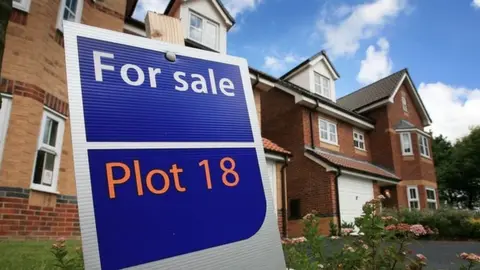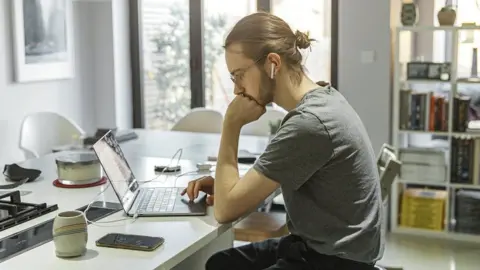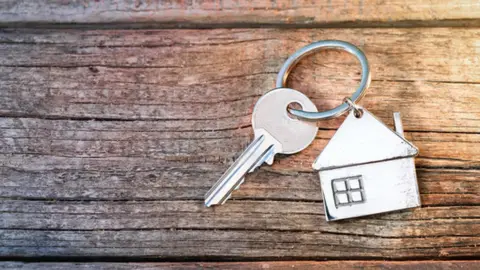House prices in Scotland fall for first time since Covid
 Getty Images
Getty ImagesProperty experts are reporting the first fall in the price of buying a home in Scotland since the market was disrupted by Covid.
Most chartered surveyors told their trade association that they had seen prices going down since April.
The Royal Institution of Chartered Surveyors (RICS) last reported such a decline in June 2020.
Last week Nationwide said UK house prices dropped at their fastest annual rate for 14 years in July.
Higher interest rates have made mortgages more expensive in recent months, while rising prices have hit people's spending power.
When RICS last reported a price decline three years ago, showings were not allowed due to the pandemic and there was widespread economic uncertainty about jobs and incomes.
Over the three months to July, it said every other part of Britain had a more negative opinion about prices while there was a less negative response in Northern Ireland.
The survey found a sharp deterioration in the price outlook for three months ahead, and in the number of transactions.
As interest rates have risen steadily over the past 20 months, the number of prospective buyers coming into the Scottish homes market is down, according to a clear majority of RICS surveyors.
More were reporting a negative outlook than at any time since the middle of last decade.
Although this way of measuring market sentiment shows how opinion is shifting, the figures do not show how much prices or the number of transactions has been falling, or are expected to fall.
 Getty Images
Getty ImagesComment from surveyors pointed to the increased cost of borrowing money for mortgages as the main cause of the market slowdown.
Alan Kennedy, of Shepherd surveyors in Fraserburgh, said higher interest rates had "stifled market activity, though demand still exceeds supply in some sectors".
If demand outstrips supply, that can sustain prices or even push them up, despite borrowing costs going up.
Craig Henderson, of Graham & Sibbald in Ayrshire, said: "The ongoing inflationary pressures are causing buyers to think long and hard over any purchase decision.
"Prices are holding up, so far in this area, but where they go later in the year will depend on the costs of borrowing and ongoing inflation. Caution is at the forefront of most of the market."
 Getty Images
Getty ImagesGreg Davidson, of the same company in Perth, added: "There remains hesitancy in some sectors of the market due to increased costs, but the underlying market seems to be stable.
"There continues to be a lack of supply in some key areas within the country house market and demand still outweighs supply."
Simon Rubinsohn, chief economist at RICS, said pressure on buyers was extending to renters, who were also finding that supply was failing to match demand for property leases.
He added: "Demand shows no signs of letting up, supply remains constrained and that means rents are likely to continue rising sharply despite the cost-of-living crisis."
The most recent figures from Registers of Scotland for actual transactions in Scotland shows an increase in prices by 3.2% over the year to May, taking the average house price to £193,000. At the same time, UK house prices increased by 1.9%.
But a different take on the market, published on Monday by Halifax, the biggest mortgage lender with its own House Price Index, showed Scottish prices down by 0.7% in the past year, while UK prices were down 2.4%.
August last year was seen as the peak for the market, after annual inflation in prices had risen above 12%. So the fall in prices now do not cancel out the sharp increases that followed the pandemic.
 PA
PAPent-up demand for homes after the market re-opened reflected a desire for more space following lockdown. And with more people working from home and no longer commuting regularly, there was demand for homes further from cities.
In the new-build market, the major housebuilders have been reporting to investors on a softening market, with rising construction costs. Several are cutting back on plans for the number of homes they are building.
Bellway said on Wednesday that completions are expected to fall, and the buyer reservation rate for new homes is down by 28% this year, to 156 per week.
Meanwhile, Taylor Wimpey recently reported that it sold 5,120 flats and houses in the first half of this year, down by quarter on the same period last year, while profit margins were cut by nearly a third.
The average price for its sales was up by nearly 7% on last year, to £320,000.
Persimmon Homes reported new house completions across the UK in the first half of this year were down by more than a third on the same part of last year.
Pre-tax profit for that period were down nearly two-thirds.
A spokesman for trade body Homes for Scotland said Scotland's market had held up well in "clearly challenging" conditions.
He said: "Our key concern relates to the shortfall of more than 114,000 new homes that has accumulated since 2008, in the wake of the financial crisis.
"With latest statistics showing the number of new starts on a worrying downward trend and a near 50% drop in the number of major residential planning applications compared to pre-Covid levels, Scotland's housing crisis looks set to worsen.
"We need urgent action on planning, a joined-up approach on the transition to net zero and support for both first-time buyers and small and medium-scale home builders."
While those wanting to get on the housing ladder will welcome a fall in prices, owners and property agents will be relieved to see mortgage rates falling, easing the downward pressure on prices.
Even though there could be another rise in the Bank of England base rate, money markets are pricing in a fall over the term of fixed rate mortgages, which is being reflected in the longer-term rates at which lenders are funding their products.
On Wednesday, Halifax - the biggest mortgage lender, part of Lloyds Banking Group and supplier of mortgage products to Bank of Scotland - joined several other major lenders with a rate cut.
